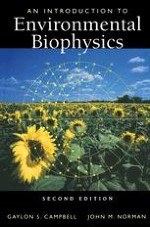1998 | OriginalPaper | Buchkapitel
Wind
verfasst von : Gaylon S. Campbell, John M. Norman
Erschienen in: An Introduction to Environmental Biophysics
Verlag: Springer New York
Enthalten in: Professional Book Archive
Aktivieren Sie unsere intelligente Suche, um passende Fachinhalte oder Patente zu finden.
Wählen Sie Textabschnitte aus um mit Künstlicher Intelligenz passenden Patente zu finden. powered by
Markieren Sie Textabschnitte, um KI-gestützt weitere passende Inhalte zu finden. powered by
As living organisms, we are most acutely aware of three things about the wind. We know that it exerts a force on us and other objects against which it blows, it is effective in transporting heat from us, and it is highly variable in space and time. A fourth property of the wind, less obvious to the casual observer, but essential to terrestrial life as we know it, is its effective mixing of the atmospheric boundary layer of the earth. This can be illustrated by a simple example. On a hot summer day about 10 kilograms (550 moles) of water can be evaporated into the atmosphere from each square meter of vegetated ground surface. This amount of water would increase the vapor concentration in a 100 m thick air layer by 100 g m−3 (136 mmol/mol) if there were no transport out of this layer or condensation within it. This is much more water than the air could hold at normal temperature. The observed increase in vapor concentration in the first 100 meters of the atmosphere is typically less than 1 g m−3, so we can see how effective the atmosphere is for transporting and mixing. A similar calculation (Monteith, 1973) shows that photosynthesis in a normally growing crop would use all of the CO2 in a 30 m air layer above a crop in a day, yet measured CO2 concentrations have diurnal fluctuations of 15 percent or less. Without the vertical turbulent transport of heat, water vapor, CO2, oxygen, and other atmospheric constituents, the microenvironment we live in would be very inhospitable.
